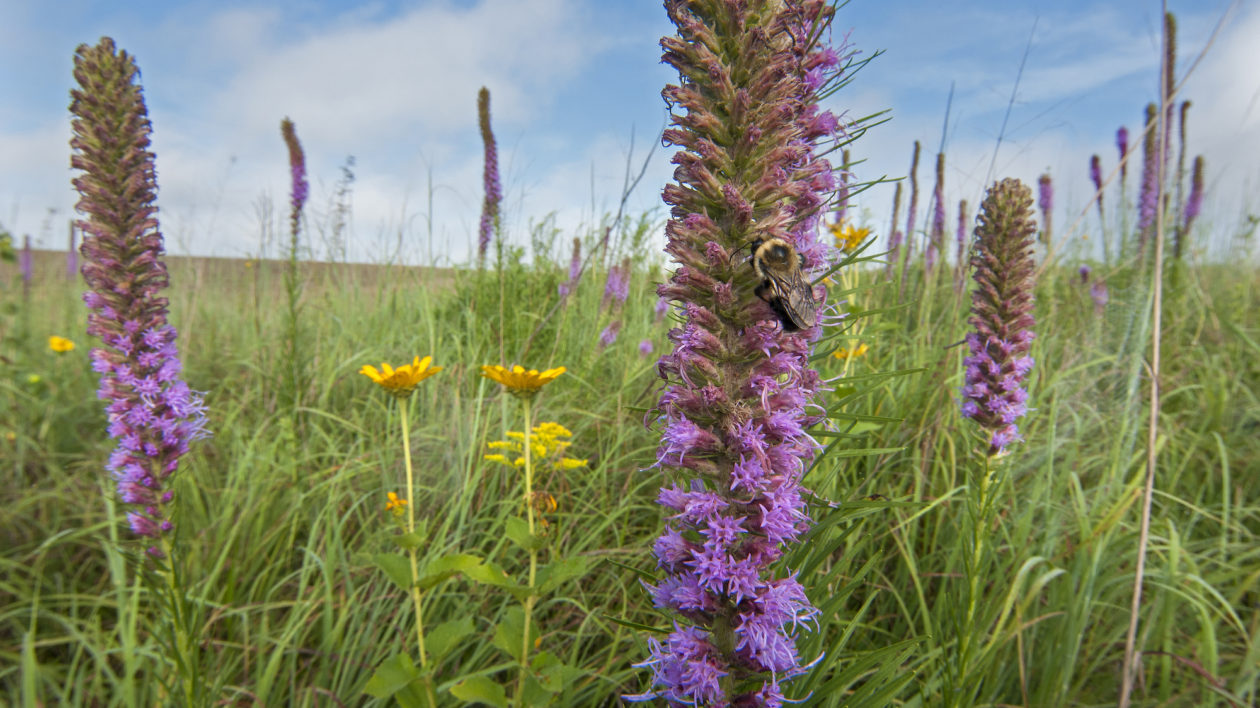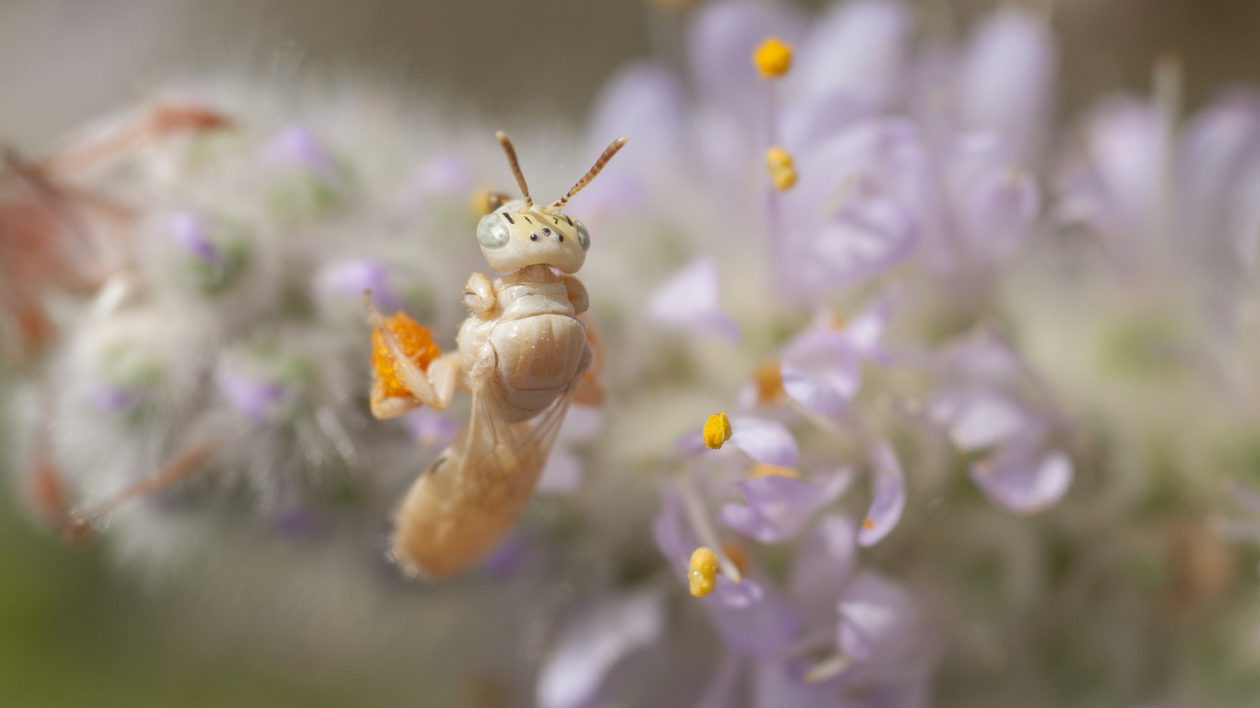The public is very aware that we are in the midst of a pollination crisis. In fact, concern about bees and other pollinators is nearly unanimous in public polling.
At a time when we are polarized on most issues, the need to do something about bees is something we can all agree on. Unfortunately, when people fret about bees and the threats they face, most are thinking about strictly about honey bees.
Honey bees are fascinating creatures. They’ve got an incredible social structure within their hives, they play important roles in the pollination of many food plants we like, and honey is delicious. However, honey bees are also an introduced livestock species in North America and only one of about 4,000 kinds of bees found in North America.
The thousands of native bee species living mostly below our collective radar are split into categories such as digger bees, carpenter bees, mason bees, sweat bees, bumble bees, and cuckoo bees.
The majority of those species don’t live in hives where workers cater to the needs of the queen and raise her babies for her. Instead, most native bees are reared in small nests built and tended by single mothers. Those female bees lay eggs, supply them with food, and protect them from enemies – all by themselves. A distinct minority of native bees live under some kind of cooperative system, and only a very few employ the kind of eusocial behavior we associate with honey bees.

The Dizzying Variety of Native Bees
Native bees also come in a dizzying array of colors, shapes, and feeding preferences. Bumble bees can be as large as your thumb, but many bee species are smaller than a grain of rice. Some are generalists that can feed opportunistically on whichever flowers are most abundant at the time.
Others are much more restricted in their diet, sometimes to a single species or group of species of wildflower. Plants, in turn, display a broad diversity of flower designs that can either make their nectar and pollen available to all comers or limited to only bees of a certain size, tongue length, or ability to vibrate flowers at a specific frequency.
Despite the astonishing variety among bees in North America, most conversations about bee conservation center on a single, largely agricultural species. Imagine if we did the same thing with birds — we’d be trying to raise more turkeys on farms out of concern for massive declines in overall bird populations.

To be clear, honey bees really are suffering declines. In fact, a recent report showed that around 38 percent of managed honey bee colonies in the U.S. were lost during the winter of 2018-19.
Honey bees are in no real danger of extinction, however, because humans are managing their populations. Native bees don’t have that kind of support system.
Honey bees also don’t cover the wide range of ecological roles played by our diverse native bee communities. The aforementioned variety of features and behaviors found within native bees means they can meet the needs of an incredible diversity of flowering plants. In contrast, honey bees provide pollination for a relatively small percentage of native flower species (estimates from around the world vary between 25 percent and 40 percent). In order to conserve the full species diversity and resilience of our ecosystems, we need our native bees.

The Fate of Native Bees
In addition to their inability to shoulder the entire load of pollination, there is also growing evidence that honey bees compete with and potentially contribute to the declines of native bees. That’s concerning, and it should make us thoughtful about how and where we place honey bee hives in and around natural areas. However, it’s also important to know that honey bees are not the primary reason our native bees are suffering.
In fact, honey bees and native bees share most of the same threats to their survival, with the loss of quality habitat topping that list. Similarly, many of the strategies to help save native bees will also help honey bees — and vice versa. We just need to be careful that saving honey bees aren’t the primary focus of conservation efforts or communications.
Increasing the size and quality of habitat for pollinators will boost populations of all bees, including both native bees and honey bees. Yes, certain pesticides and diseases are also causing major problems and we should continue to work on those issues as well.

However, adequate habitat quantity and quality greatly dampens the impacts of those other threats. We need to protect and restore plant diversity in natural areas and agricultural landscapes so that nectar and pollen resources are abundantly available throughout the year. In addition, we need to rebuild and reconnect floristically rich habitats wherever we can. Those are the only viable strategies to conserve bees of all kinds (and most of our native biodiversity).
Compared to those gargantuan tasks, changing the way we talk about bees seems pretty easy, but it is still really important. There are too many news stories that start with something like, “bees are suffering” and then proceed to talk only about honey bees.
Schools talk a lot about the social structure of honey bees, but don’t mention the majority of bees that don’t live that way. As a result, much of the public recognizes that we are experiencing a pollination catastrophe but thinks it’s an issue of bee keepers and their struggles to save their animals.
The real story of pollinators and their declines is much more compelling than the battle to save a livestock industry. The incredible variety among native bees, alone, can catch the public’s attention, especially when accompanied by photos showing the broad range of size, color, and shape among those bees.

People can also empathize easily with the extraordinary challenges facing single mom bees trying to feed and protect their progeny in a world of habitat fragmentation and degradation. Including butterflies, moths, flies, wasps and other insects in the discussion provides even more fascinating pollinator accounts and images.
The pollinator narrative is also easy to frame in ways that fit into the broader conservation context. Pollinators rely on habitat size, habitat connectivity, and plant diversity. Those are the key components of conservation success for most other species too, including our own.
Rebuilding and protecting the healthy and resilient landscapes bees need will provide for the needs of both nature and people. That’s a story we should be telling.

The public already cares about pollinators; we just need to be smarter about how we talk about them. If we’re successful, we’ll save much more than just bees. We can start by fixing our myopic focus on honey bees.
Turkeys are impressive and interesting creatures, but we’d never choose them as the primary focus of our bird conservation communications and strategies. Why, then, are we following that pattern for bees?
Let’s celebrate the incredible diversity of our native bee and pollinator communities and be more creative in the ways we engage the public on the topic of pollinator conservation. With 4,000 bee species in North America, along with countless other species of pollinators, it’s not like we’re short on material.




Thanks for information on various bees that pollenate various plant species. I plant various flowers and enjoy watching the pollen species.
Having moved from California to Virginia after the Camp Fire I have seen firsthand and can attest to the immense diversity of bee types in Virginia. I’ve set out upon the task of getting to know them and generating habitat and food sources for them. It’s a fascination and rewarding journey! What beautiful little creatures!!!
Amazingly important, wonderful article. I’m working furiously to diversify flora on my property to accommodate all pollinators and will be getting mason bees next spring.
Informative articles like this one are the reason I joined The Nature Conservancy. Thank you for NOT mentioning “climate change”.
I agree 100% Chris.
Something is killing honeybees. Native species are struggling from habitat loss. The abatement strategies are immensely different.
I witnessed something last fall that “honeybee people” should consider: I have a bad Coke Zero habit. One sunny morning after a cold crisp night, I witnessed a continuous stream of honey bees traveling in and out of a small hole in the garbage can I use to keep my empty pop cans in. It was 100% Coke Zero cans… It was clear the bees were ‘nectaring’ on asparatame.
Now I don’t propose that this is the honeybee’s problem, but it could contribute. Every bee in a large radius was keyed in on this ‘nectar’ source. It wouldn’t provide them the energy they needed to find real nectar (at a time when flowers are sparse) and it would be a bad way to go into a cold Iowa winter… Are ‘energy sinks’ an issue? It’s worth a second thought.
Hope all is well in NE, Chris!
Don’t forget the wasps and hornets. I live in high Steppe/ Sage country. We have quite a few wasp pollinators, in addition to several different types of bumble bees, and bee flies too!
Excellent blog! I am reporting to “the great sunflower project” which is collecting data on all pollinators. It’s lots of fun and only requires 7 minutes a day and as many days as observer chooses to report.
Wow! I had no idea there were so many different kinds of bees. Our world is so big and we really know so little. Thank you for providing information that not only educates us, but also entertains us and entices us to become more involved in this wonderful worlrd.
I love native bees and keep native plants in my garden that local bees and other insects have relationships with. Although I am in an suburban setting at least a mile away from the natural habitats of these native plants a large variety of tiny bees to huge Carpenter bees visit my flowers every day of the year weather allowing. A large variety of other beneficial insects including many types of gentle wasps also make regular stops. I wish I could post some of the photos I have taken here.
I never knew! I would love to have a garden for polinators.. This year I fought the Chinese Beatles eating my flowers without killing the bumblebees.
THANK YOU FOR THE TIME AND EFFORTS TO PUBLISH THIS ARTICLE. I REALLY HAD NO IDEA ABOUT MANY OF THESE NATIVE POLLINATORS AND WILL SAVE THIS ARTICLE FOR REFERENCE.
GOOD JOB!!!!
Incredible, I learned a lot from this article.
Does the spraying with Sumethrin affect (kill) native ground bees and other pollinators? Our town is spraying 3 to 4 times from helicopters and roads to kill mosquitos. I s it also killing food sources of protein that birds need?
Thanks for your rousing article and terrific photos, Chris. I knew little about native bees until I started researching the literature and spending “deep look” time in my garden, in part, for a pollinator garden workbook I developed. It’s been a tough year for bees here on the northern CA coast (numbers down), so I know everything I plant and keep going is that much more important. My talks on pollinators always emphasize the importance of our native bees. It’s heartening to see the excitement people have when they discover these amazing insects. As for me, a whole new and deeper world opens up.
This is so very interesting. I hope you do a follow up story on native bees in Colorado and which ones live in prairie, foothills habitat, and higher elevation montane habitat. This regional approach would really be helpful. Then I can adapt my nature-watching and landscaping habits to the region I live in, and I can talk with my neighbors who would be most interested in regional/local native bees. Maybe TNC-Colorado can provide this? I hope you take this next step! Thank you so much!